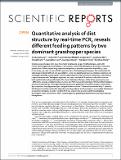Files in this item
Quantitative analysis of diet structure by real-time PCR, reveals different feeding patterns by two dominant grasshopper species
Item metadata
| dc.contributor.author | Huang, Xunbing | |
| dc.contributor.author | Wu, Huihui | |
| dc.contributor.author | McNeill, Mark Richard | |
| dc.contributor.author | Qin, Xinghu | |
| dc.contributor.author | Ma, Jingchuan | |
| dc.contributor.author | Tu, Xiongbing | |
| dc.contributor.author | Cao, Guangchun | |
| dc.contributor.author | Wang, Guangjun | |
| dc.contributor.author | Nong, Xiangqun | |
| dc.contributor.author | Zhang, Zehua | |
| dc.date.accessioned | 2017-02-27T10:30:14Z | |
| dc.date.available | 2017-02-27T10:30:14Z | |
| dc.date.issued | 2016-08-26 | |
| dc.identifier | 249230310 | |
| dc.identifier | 453f1e9a-4b68-42e7-887b-1ecec2b1a1d4 | |
| dc.identifier | 84983652679 | |
| dc.identifier.citation | Huang , X , Wu , H , McNeill , M R , Qin , X , Ma , J , Tu , X , Cao , G , Wang , G , Nong , X & Zhang , Z 2016 , ' Quantitative analysis of diet structure by real-time PCR, reveals different feeding patterns by two dominant grasshopper species ' , Scientific Reports , vol. 6 , 32166 . https://doi.org/10.1038/srep32166 | en |
| dc.identifier.issn | 2045-2322 | |
| dc.identifier.other | ORCID: /0000-0003-2351-3610/work/60631059 | |
| dc.identifier.uri | https://hdl.handle.net/10023/10372 | |
| dc.description | This study was supported by the National Natural Science Foundation of China, 31471823, the Earmarked Fund for China Agriculture Research System, CARS-35-07, and the Innovation Project of Chinese Academy of Agricultural Science. | en |
| dc.description.abstract | Studies on grasshopper diets have historically employed a range of methodologies, each with certain advantages and disadvantages. For example, some methodologies are qualitative instead of quantitative. Others require long experimental periods or examine population-level effects, only. In this study, we used real-time PCR to examine diets of individual grasshoppers. The method has the advantage of being both fast and quantitative. Using two grasshopper species, Oedaleus asiaticus and Dasyhippus barbipes, we designed ITS primer sequences for their three main host plants, Stipa krylovii, Leymus chinensis and Cleistogenes squarrosa and used real-time PCR method to test diet structure both qualitatively and quantitatively. The lowest detection efficiency of the three grass species was ~80% with a strong correlation between actual and PCR-measured food intake. We found that Oedaleus asiaticus maintained an unchanged diet structure across grasslands with different grass communities. By comparison, Dasyhippus barbipes changed its diet structure. These results revealed why O. asiaticus distribution is mainly confined to Stipa-dominated grassland, and D. barbipes is more widely distributed across Inner Mongolia. Overall, real-time PCR was shown to be a useful tool for investigating grasshopper diets, which in turn offers some insight into grasshopper distributions and improved pest management. | |
| dc.format.extent | 11 | |
| dc.format.extent | 812621 | |
| dc.language.iso | eng | |
| dc.relation.ispartof | Scientific Reports | en |
| dc.subject | QH301 Biology | en |
| dc.subject | NDAS | en |
| dc.subject.lcc | QH301 | en |
| dc.title | Quantitative analysis of diet structure by real-time PCR, reveals different feeding patterns by two dominant grasshopper species | en |
| dc.type | Journal article | en |
| dc.contributor.institution | University of St Andrews. School of Biology | en |
| dc.identifier.doi | 10.1038/srep32166 | |
| dc.description.status | Peer reviewed | en |
This item appears in the following Collection(s)
Items in the St Andrews Research Repository are protected by copyright, with all rights reserved, unless otherwise indicated.

